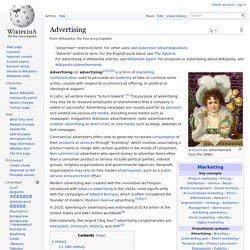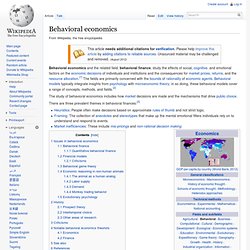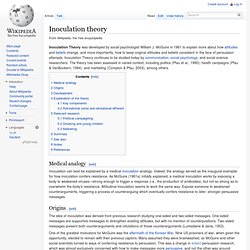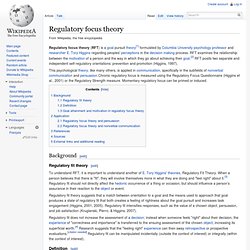

Advertising. "Adverts" redirects here.

For the English punk band, see The Adverts. Advertising (or advertizing)[1][2][3] is a form of marketing communication used to persuade an audience to take or continue some action, usually with respect to a commercial offering, or political or ideological support. Modern advertising was created with the innovative techniques introduced with tobacco advertising in the 1920s, most significantly with the campaigns of Edward Bernays, which is often considered the founder of modern, Madison Avenue advertising.[5][6][7] In 2010, spending on advertising was estimated at $143 billion in the United States and $467 billion worldwide[8] Internationally, the largest ("big four") advertising conglomerates are Interpublic, Omnicom, Publicis, and WPP.[9] History[edit] Egyptians used papyrus to make sales messages and wall posters.
In the 18th century advertisements started to appear in weekly newspapers in England. 19th century[edit] Thomas J. Behavioral economics. There are three prevalent themes in behavioral finances:[3] Issues in behavioral economics[edit] Behavioral finance[edit] The central issue in behavioral finance is explaining why market participants make systematic errors contrary to assumption of rational market participants.[1] Such errors affect prices and returns, creating market inefficiencies.

It also investigates how other participants take advantage (arbitrage) of such market inefficiencies. Behavioral finance highlights inefficiencies such as under- or over-reactions to information as causes of market trends (and in extreme cases of bubbles and crashes). Herd behavior. Herd behavior describes how individuals in a group can act together without planned direction.

The term pertains to the behavior of animals in herds, flocks, schools, demonstrations, riots and general strikes,[1] sporting events, religious gatherings, episodes of mob violence and everyday decision-making, judgment and opinion-forming. Contagion effect. Subprime Crisis Diagram Financial contagion refers to a scenario in which small shocks, which initially affect only a few financial institutions or a particular region of an economy, spread to the rest of financial sectors and other countries whose economies were previously healthy, in a manner similar to the transmission of a medical disease.
Financial contagion happens at both the international level and the domestic level. International financial contagion, which happens in both advanced economies and developing economies, is the transmission of financial crisis across financial markets for direct or indirect economies. However, under today's financial system, with large volume of cash flow, such as hedge fund and cross-regional operation of large banks, financial contagion usually happens simultaneously both among domestic institutions and across countries.
Elaboration likelihood model. The Elaboration Likelihood Model (ELM) of persuasion [1] is a dual process theory of how attitudes are formed and changed, which was developed by Richard E.

Petty and John Cacioppo during the early 1980s. The model examines how an argument's position on the "elaboration continuum", from processing and evaluating (high elaboration) to peripheral issues such as source expertise or attractiveness (low elaboration), shapes its persuasiveness. ELM resembles the heuristic-systematic model of information processing developed about the same time by Shelly Chaiken. Inoculation theory. Medical analogy[edit] Inoculation can best be explained by a medical inoculation analogy.

Indeed, the analogy served as the inaugural exemplar for how inoculation confers resistance. As McGuire (1961a) initially explained, a medical inoculation works by exposing a body to weakened viruses—strong enough to trigger a response (i.e., the production of antibodies), but not so strong as to overwhelm the body's resistance. Attitudinal inoculation seems to work the same way: Expose someone to weakened counterarguments, triggering a process of counterarguing which eventually confers resistance to later, stronger persuasive messages.
Origins[edit] The idea of inoculation was derived from previous research studying one-sided and two-sided messages. Regulatory focus theory. Regulatory focus theory (RFT) is a goal pursuit theory[1] formulated by Columbia University psychology professor and researcher E.

Tory Higgins regarding peoples' perceptions in the decision making process. RFT examines the relationship between the motivation of a person and the way in which they go about achieving their goal.[2] RFT posits two separate and independent self-regulatory orientations: prevention and promotion (Higgins, 1997). This psychological theory, like many others, is applied in communication, specifically in the subfields of nonverbal communication and persuasion.Chronic regulatory focus is measured using the Regulatory Focus Questionnaire (Higgins et al., 2001) or the Regulatory Strength measure. Momentary regulatory focus can be primed or induced. Persuasion. Brief history[edit] Persuasion began with the Greeks, who emphasized rhetoric and elocution as the highest standard for a successful politician.

All trials were held in front of the Assembly, and both the prosecution and the defense rested, as they often do today, on the persuasiveness of the speaker.[5] Rhetoric was the ability to find the available means of persuasion in any instance. The Greek philosopher Aristotle listed four reasons why one should learn the art of persuasion: truth and justice are perfect; thus if a case loses, it is the fault of the speakerit is an excellent tool for teachinga good rhetorician needs to know how to argue both sides to understand the whole problem and all the options, andthere is no better way to defend one’s self. Theories[edit] Attribution theory[edit] Humans attempt to explain the actions of others through either dispositional attribution or situational attribution.